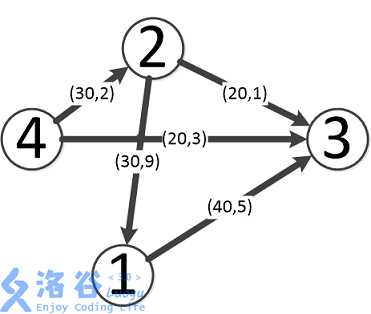题目描述
如题,给出一个网络图,以及其源点和汇点,每条边已知其最大流量和单位流量费用,求出其网络最大流和在最大流情况下的最小费用。
输入输出格式
输入格式:
第一行包含四个正整数N、M、S、T,分别表示点的个数、有向边的个数、源点序号、汇点序号。
接下来M行每行包含四个正整数ui、vi、wi、fi,表示第i条有向边从ui出发,到达vi,边权为wi(即该边最大流量为wi),单位流量的费用为fi。
输出格式:
一行,包含两个整数,依次为最大流量和在最大流量情况下的最小费用。
输入输出样例
输入样例#1:
4 5 4 3 4 2 30 2 4 3 20 3 2 3 20 1 2 1 30 9 1 3 40 5
输出样例#1:
50 280
说明
时空限制:1000ms,128M
(BYX:最后两个点改成了1200ms)
数据规模:
对于30%的数据:N<=10,M<=10
对于70%的数据:N<=1000,M<=1000
对于100%的数据:N<=5000,M<=50000
样例说明:

如图,最优方案如下:
第一条流为4-->3,流量为20,费用为3*20=60。
第二条流为4-->2-->3,流量为20,费用为(2+1)*20=60。
第三条流为4-->2-->1-->3,流量为10,费用为(2+9+5)*10=160。
故最大流量为50,在此状况下最小费用为60+60+160=280。
故输出50 280。
spfa费用流
#include<queue> #include<cstdio> #include<cstring> #include<algorithm> using namespace std; const int maxn = 4*50000; inline int read() { int x=0,f=1;char c= getchar(); while(c<'0'||c>'9'){if(c=='-')f=-1;c=getchar();} while(c>='0'&&c<='9'){x=(x<<1)+(x<<3)+(c-'0');c=getchar();} return f*x; } struct node{ int u,v,cost,flow,next; }edge[maxn]; int head[maxn],num=1,n,m,s,t; int min_cost=0,max_flow=0; int dis[maxn],pre[maxn]; bool vis[maxn]; inline void add_edge(int x,int y,int z,int c) { edge[++num].v=y;edge[num].u=x;edge[num].flow=z;edge[num].cost=c;edge[num].next=head[x];head[x]=num; } bool spfa() { memset(dis,0x3f,sizeof dis); memset(vis,0,sizeof vis); vis[s]=1; dis[s]=0; queue<int>que; que.push(s); while(!que.empty()) { int u=que.front(); que.pop(); for(int i=head[u];i;i=edge[i].next) { int v=edge[i].v; if(dis[u]+edge[i].cost<dis[v]&&edge[i].flow>0) { dis[v]=edge[i].cost+dis[u]; pre[v]=i; if(!vis[v]) { que.push(v); vis[v]=1; } } } vis[u]=0; } if(dis[t]==0x3f3f3f3f)return 0; else return 1; } void work() { int ma=0x3f3f3f3f; for(int i=t;i!=s;i=edge[pre[i]].u) ma=min(edge[pre[i]].flow,ma); for(int i=t;i!=s;i=edge[pre[i]].u) { edge[pre[i]].flow-=ma; edge[pre[i]^1].flow+=ma; min_cost+=(ma*edge[pre[i]].cost); } max_flow+=ma; } void miku() { while(spfa()) work(); } int main() { n=read(),m=read(),s=read(),t=read(); int a,b,c,d; while(m--) { a=read(),b=read(),c=read(),d=read(); add_edge(a,b,c,d); add_edge(b,a,0,-d); } miku(); printf("%d %d ",max_flow,min_cost); return 0; }